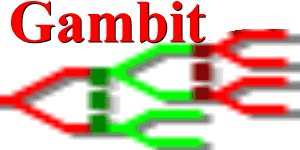gambit-enumpoly: Compute equilibria of a game using polynomial systems of equations#
gambit-enumpoly reads a game on standard input and computes Nash equilibria by solving systems of polynomial equations and inequalities.
This program searches for all Nash equilibria in a strategic game using a support enumeration approach. This approach computes all the supports which could, in principle, be the support of a Nash equilibrium, and then searches for a totally mixed equilibrium on that support by solving a system of polynomial equalities and inequalities formed by the Nash equilibrium conditions. The ordering of the supports is done in such a way as to maximize use of previously computed information, making it suited to the computation of all Nash equilibria.
When the verbose switch -v is used, the program outputs each support as it is considered. The supports are presented as a comma-separated list of binary strings, where each entry represents one player. The digit 1 represents a strategy which is present in the support, and the digit 0 represents a strategy which is not present. Each candidate support is printed with the label “candidate,”.
Note that the subroutine to compute a solution to the system of polynomial equations and inequalities will fail in degenerate cases. When the verbose switch -v is used, these supports are identified on standard output with the label “singular,”. It is possible that there exist equilibria, often a connected component of equilibria, on these singular supports.
- -d#
Express all output using decimal representations with the specified number of digits.
- -h#
Prints a help message listing the available options.
- -H#
By default, the program uses an enumeration method designed to visit as few supports as possible in searching for all equilibria. With this switch, the program uses a heuristic search method based on Porter, Nudelman, and Shoham [PNS04], which is designed to minimize the time until the first equilibrium is found. This switch only has an effect when solving strategic games.
- -S#
By default, the program uses behavior strategies for extensive games; this switch instructs the program to use reduced strategic game strategies for extensive games. (This has no effect for strategic games, since a strategic game is its own reduced strategic game.)
- -q#
Suppresses printing of the banner at program launch.
- -v#
Sets verbose mode. In verbose mode, supports are printed on standard output with the label “candidate” as they are considered, and singular supports are identified with the label “singular.” By default, no information about supports is printed.
Computing equilibria of the extensive game e01.efg, the example in Figure 1 of Selten
(International Journal of Game Theory, 1975) sometimes called
“Selten’s horse”:
$ gambit-enumpoly e01.efg
Compute Nash equilibria by solving polynomial systems
Gambit version 16.2.0, Copyright (C) 1994-2024, The Gambit Project
Heuristic search implementation Copyright (C) 2006, Litao Wei
This is free software, distributed under the GNU GPL
NE,0.000000,1.000000,0.333333,0.666667,1.000000,0.000000
NE,1.000000,0.000000,1.000000,0.000000,0.250000,0.750000
NE,1.000000,0.000000,1.000000,0.000000,0.000000,0.000000
NE,0.000000,1.000000,0.000000,0.000000,1.000000,0.000000
